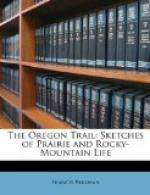Early in the morning after we reached the Platte, a long procession of squalid savages approached our camp. Each was on foot, leading his horse by a rope of bull-hide. His attire consisted merely of a scanty cincture and an old buffalo robe, tattered and begrimed by use, which hung over his shoulders. His head was close shaven, except a ridge of hair reaching over the crown from the center of the forehead, very much like the long bristles on the back of a hyena, and he carried his bow and arrows in his hand, while his meager little horse was laden with dried buffalo meat, the produce of his hunting. Such were the first specimens that we met—and very indifferent ones they were—of the genuine savages of the prairie.
They were the Pawnees whom Kearsley had encountered the day before, and belonged to a large hunting party known to be ranging the prairie in the vicinity. They strode rapidly past, within a furlong of our tents, not pausing or looking toward us, after the manner of Indians when meditating mischief or conscious of ill-desert. I went out and met them; and had an amicable conference with the chief, presenting him with half a pound of tobacco, at which unmerited bounty he expressed much gratification. These fellows, or some of their companions had committed a dastardly outrage upon an emigrant party in advance of us. Two men, out on horseback at a distance, were seized by them, but lashing their horses, they broke loose and fled. At this the Pawnees raised the yell and shot at them, transfixing the hindermost through the back with several arrows, while his companion galloped away and brought in the news to his party. The panic-stricken emigrants remained for several days in camp, not daring even to send out in quest of the dead body.




